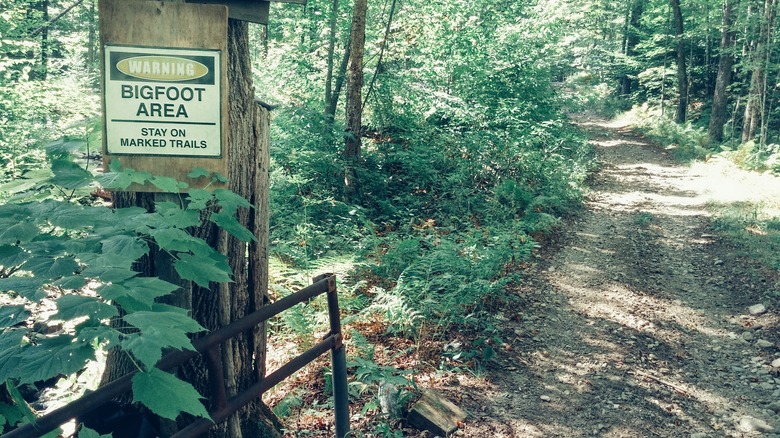Bigfoot Has An FBI File – And It's Strange
Believe it or not, the FBI once investigated Bigfoot – and earlier this month, more than 40 years after said investigation, the bureau released its results.
Fifteen hairs, attached to a small piece of skin, found in the forest somewhere in the Pacific Northwest and submitted to the FBI by Bigfoot Information Center and Exhibition Director Peter Byrne in 1976: "of deer family origin."
That's what the FBI said in its records of the investigation, released June 5 – much to the dismay of Byrne, now 93.
"We're just finding this out," Byrne, who was born in Ireland, told the Washington Post. "It's disappointing."
How the Investigation Happened
How the Investigation Happened
In the mid-1970s, two biologists and U.S. Forest Service employees claimed to have spotted an unidentified creature walking between a pair of trees in a forested area of the Pacific Northwest. Upon hearing of this "credible sighting," as he called it, Byrne traveled to the site of the sighting and found that now-famous tuft of hair, snagged on a tree. He sent it in to the FBI, asking for an agent to "arrange for a comparative analysis of some hairs that we have here which we are unable to identify."
"Please understand that our research here is serious," Byrne wrote in his letter. "This is a serious question that needs answering."
Byrne told the Washington Post that he never heard back from the FBI, though the bureau's records show that Jay Cochran Jr., then-assistant director of the FBI's scientific and technical services division, wrote Byrne multiple times in response.
Exceptions to the Rules
Exceptions to the Rules
Cochran's first letter to Byrne referenced department policy against taking such requests.
"Occasionally, on a case-by-case basis, in the interest of research and scientific inquiry, we make exceptions to this general policy," the letter stated. "With this understanding, we will examine the hairs and tissue mentioned in your letter."
A few months later, Cochran wrote to Byrne again, stating that a study of the sample's root structure, medullary structure, cuticle thickness and scale casts revealed "that the hairs are of deer family origin." Byrne alleges that he never received Cochran's letters.
Benjamin Radford, deputy editor of Skeptical Inquirer Magazine, told History.com that the FBI conducting its Bigfoot investigation doesn't mean the bureau endorses Bigfoot's existence.
"All it means is the FBI did a favor to a Bigfoot researcher," Radford said, according to History.com. "There's nothing wrong with that, but it shouldn't be mistaken for de facto government endorsement of the reality of Bigfoot."
Byrne and Bigfoot
Byrne and Bigfoot
Byrne's Bigfoot passion sprouted in the 1940s and '50s, when his stint with the British Royal Air Force introduced him to foreigners who took interest in yeti myths, and conducting real-life yeti expeditions. Byrne ended up taking five separate trips to the Himalayas in search of a yeti, during which travels he met Americans who introduced him to the American concept of Bigfoot.
Byrne told the Washington Post that while he found Bigfoot theories laughable at first, he was drawn into them. He has since traveled all over the world, leading Bigfoot research projects and writing books about the yeti.
Now in his 90s, Byrne is still searching for evidence of Bigfoot, and the FBI's analysis results have not deterred him. If the FBI said his sample from the '70s was deer hair, true Bigfoot evidence must still exist – somewhere.
References
- FBI Records – The Vault: Bigfoot Part 01 of 01
- History.com: Bigfoot Was Investigated by the FBI. Here's What They Found.
- The Washington Post: He Asked the FBI to Analyze 'Bigfoot' Hair 40 Years Ago and Never Heard Back. Until Now.
- Live Science: Bigfoot's FBI File Reveals Strange Story of a Monster Hunter and 15 Mysterious Hairs
Cite This Article
MLA
Swanston, Brenna. "Bigfoot Has An FBI File – And It's Strange" sciencing.com, https://www.sciencing.com/bigfoot-has-an-fbi-file-and-its-strange-13719451/. 18 June 2019.
APA
Swanston, Brenna. (2019, June 18). Bigfoot Has An FBI File – And It's Strange. sciencing.com. Retrieved from https://www.sciencing.com/bigfoot-has-an-fbi-file-and-its-strange-13719451/
Chicago
Swanston, Brenna. Bigfoot Has An FBI File – And It's Strange last modified March 24, 2022. https://www.sciencing.com/bigfoot-has-an-fbi-file-and-its-strange-13719451/
